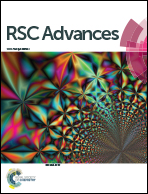A novel method for the synthesis of benzothiazole heterocycles catalyzed by a copper–DiAmSar complex loaded on SBA-15 in aqueous media†
Abstract
Cu(II)–DiAmSar complex functionalized mesoporous SBA-15 silica support was employed for the synthesis of benzothiazole heterocycles in aqueous media as a green solvent with excellent yields. The resulting novel catalyst is extraordinarily stable and inhibits leaching of the metal ions from the SBA-15 support. Furthermore, it showed good heterogeneous catalytic activity in the synthesis of the previously mentioned heterocycles and could also be recycled from the reaction mixture and reused six times. The nature of the support after the anchoring of Cu(II)–DiAmSar complex on the surface of SBA-15 nanochannels and successful anchoring were examined using X-ray diffraction, transmission electron microscopy, nitrogen physical adsorption, Fourier transform infrared studies and thermogravimetric analysis.


 Please wait while we load your content...
Please wait while we load your content...